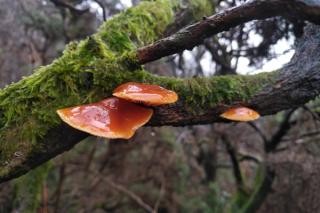
How nature can support the climate crisis: A focus on fungi
- Post Date
- 22 April 2024
- Read Time
- 5 minutes

There is increasing recognition of the role nature plays in supporting our societies and economies, and on just how much human activity has degraded our natural environments. One natural-based solution which could play a significant role in helping address the climate and nature crises is fungi. This article will focus on the some of the many benefits of fungi for society, food security, and supporting the resilience of the global economy.
This article is a summary of the full report ‘Fungi and its value to the nature and climate crises’. You can read this via the link below:
Report - Fungi and its value to the nature and climate crises
What are fungi?
Fungi are single or multi-cellular organisms such as yeasts, moulds and mushrooms. Fungi primarily obtain their nutrients via decomposition of organic matter and form an important part of ecosystem function. Globally, the total length of mycorrhizal fungi in the top 10 cm of soil is over 450 quadrillion kilometres, nearly half the width of the Milky Way galaxy [1].
How can fungi support the climate and nature crises?
Fungi is of course known as a food source, and is also used in various medicines, such as antibiotics, anti-cancer drugs, cholesterol and ergosterol synthesis inhibitors, psychotropic drugs, immunosuppressants and fungicides. However, in addition to this, it has many specific uses which can support the climate and nature crises, these include:
Waste processing and decomposition
Traditionally fungi have been used to break down waste organic material such as food and agricultural waste, and sewage, into products such as compost. In more modern applications fungi can be used to breakdown hard to recycle products such as some plastics [2]. In addition, they can be used to remove pollutants from contaminated ground in a process known as bioremediation [3] (a nature-based solution).
Agriculture, horticulture & forestry
Inoculations of fungi are often used in forestry [4] and agriculture [5] to improve plant survival (including drought resilience) and growth (another nature-based solution). This can reduce reliance on artificial fertilisers and pesticides which are harmful to soil structure, water quality and ecosystem health [6], and are carbon intensive to produce. Management activities like ploughing break up the fungi networks reducing their efficiency, this is one of many reasons why minimal or no-plough agriculture is becoming increasingly popular in regenerative farming practices.
Carbon sequestration
Fungi are critical to carbon sequestration in many soil types. Estimates conclude that at least 5 billion tons of carbon dioxide are sequestered within the soil through the complex system of fungi mycorrhizal networks. That’s 75% of all the terrestrial CO2 on Earth, making it one of the largest carbon sinks on our planet[7]. Ecosystems with healthier, more intact fungi communities are therefore likely to be more capable of sequestering carbon and combatting the climate crisis, this includes productive agricultural land where it is under appropriate management e.g. regenerative agriculture.
Biodiversity Net Gain
When looking at sites for Biodiversity Net Gain (BNG), fungi can often be overlooked. A seemingly poor-quality grassland (e.g., with patches of bare ground and a consistently short sward height) may be flagged for improvement to achieve credits for BNG projects. This could involve re-seeding and less frequent mowing regimes to improve its condition. Such changes could be detrimental to any assemblage of grassland fungi such as waxcaps that may be present.
When investigating options for improving the condition of a grassland for BNG, fungi should be considered as soon as possible. An early survey can identify if a grassland may represent an important waxcap grassland. When a waxcap grassland is identified, recommendations made by ecologists can then reflect this. However, this needs to be reflected under the biodiversity metric and fungi need a higher level of legal protection to enforce these recommendations.
Improving the condition of woodland for BNG should work hand-in-hand with fungi. The Statutory Metric Condition Sheets [8] encourage the control of herbivore damage, restrict the amount of open space and encourage the retention of fallen and standing deadwood. Inappropriate management such as clear-felling, drainage and soil damage can damage the mycelia of woodland fungi [9].
In summary, fungi provide vital products and ecosystem services for our society, and while historically they have been somewhat overlooked, they are currently receiving considerably more attention, and the science and knowledge behind how to work with fungi to create positive impacts for nature, climate, forestry, and agriculture is growing rapidly.
SLR are collaborating closely with experts in the mycology field, as well as our internal teams in ecology, carbon sequestration and regenerative agriculture, so that we can leverage knowledge around the power of fungi to deliver meaningful change in line with the targets of the global biodiversity framework. Please feel free to reach out to us if you have any questions or projects that you would like to discuss.
---------------------------------------
References
Image credit - Ida Bailey
[1] https://www.oneearth.org/mapping-the-fungi-network-that-lives-beneath-the-soil/
[3] https://www.ncbi.nlm.nih.gov/pmc/articles/PMC4920763/
[4] https://www.rhizocore.com/
[5] https://www.sciencedirect.com/science/article/pii/S1049964423000762
[6] https://environment-review.yale.edu/fungi-can-improve-agricultural-efficiency-and-sustainability-0
[7] https://www.britannica.com/science/fungus/Outline-of-classification-of-fungi
[9] https://www.woodlandtrust.org.uk/protecting-trees-and-woods/ancient-woodland-restoration/
Recent posts
-

-

-

Navigating the evolving landscape of corporate sustainability and communications in the US
by Chynna Pickens
View post